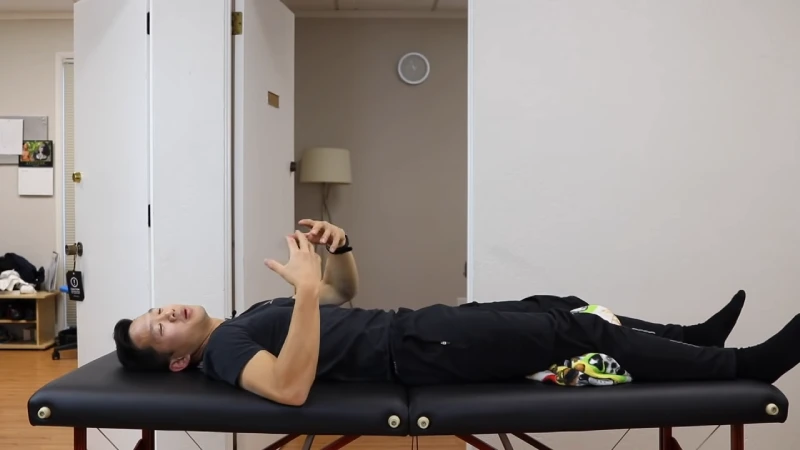Do you ever find yourself in bed, struggling to stay stable and feeling constantly moving around? If so, you may have unknowingly found yourself naturally adopting the position of sleeping with one leg bent up. While this may seem like a strange habit, logic, and science are behind it.
There are many potential reasons why you might find yourself sleeping with one leg bent up, from stability to pain relief to temperature regulation. This technique might be worth trying if you’re having trouble getting comfortable at night.
Today we will discuss why people sleep with one leg bent up and examine its pros and cons. We will also provide some tips on sleeping more comfortably in this position and answer whether or not it is bad for your health to sleep this way.
Why Do I Sleep With One Leg Bent Up: The Reasons Behind
Although sleeping with one leg bent up may seem odd, there are some scientific reasons behind this sleeping position. Such as:
#1 Stability: You May Feel Unstable in Bed
Maintaining a stable position in bed can be challenging, as the lack of support for one’s limbs may lead to an unbalanced and uneasy sensation during sleep. This is where bending up one leg comes into play as it acts as an anchor to help with weight distribution and stop us from migrating around the bed.
By keeping one leg bent, we can distribute our weight evenly across the mattress and reduce any movements that could potentially disturb our sleep. Also, sleeping with one leg bent up can provide additional stability by reducing pressure on the lower back.
#2 Height: You’re Too Tall to Fit in Your Bed
Exceptionally tall people can have trouble finding a bed that fits their height and can have trouble sleeping properly. This can result in discomfort or pain in various body parts, including the lower back, hips, knees, and ankles.
As a result, some people with larger frames may develop habits such as sleeping with one leg bent up to alleviate these symptoms. Sleeping with one leg bent up can help improve circulation and reduce pressure on certain body areas.
By elevating one leg slightly above the other while lying down, blood flow is improved and any tension or strain on joint tissues is reduced.
#3 Pain: You Might Have a Medical Condition or Pain
Pain or a medical condition may cause an individual to sleep with a bent leg. This discomfort during rest could result in the development of habits such as sleeping in certain positions.
Periodic Limb Movement Disorder (PLMD) is one possible medical condition that can lead to this habit. PLMD is characterized by involuntary movements during sleep, most commonly affecting the feet and knees, and can contribute to an increased risk of hypertension over time.
#4 Temperature Regulation: Maybe You Need it
Temperature regulation can contribute to an individual’s decision to sleep with their limbs spread out. Research has shown that a cooler bedroom temperature of around 60-67°F (15-19°C) can lead to better sleep quality.
This is because our body temperature naturally drops by a few degrees when we sleep. A cooler bedroom helps facilitate this process. Thus bending one leg up can also aid in regulating body temperature as it allows for a better spread of heat.
Pros and Cons of Sleeping with Your One Leg Bent Up
Sleeping with one leg bent up is common for many people. While it may feel comfortable and cosy, this sleep position has pros and cons.
Pros of Bent-Legged Sleeping
Adopting a posture that involves bending one leg while sleeping has been associated with several benefits:
- It can help improve breathing and reduce snoring. This is because sleeping on your back with both legs straight can cause your tongue to fall backward and block the airway, leading to snoring or sleep apnoea.
- Bent-legged sleeping can enhance comfort and familiarity. Many people find this position natural and instinctive, as it mimics the foetal position, which is how we sleep in the womb.
- Your sleep quality and health will improve when you bend one leg while sleeping. But when taking a sleep aid like Nitrazepam, lying with one leg bent can help you sleep better.
Cons of Sleeping with One Leg Bent Up
The potential drawbacks of adopting a posture that involves:
- Elevating one leg while sleeping includes exacerbation of neck pain and increased risk of experiencing pins and needles due to restricted blood flow.
- When you sleep with one leg bent up, your body weight tends to shift towards the other side, causing an imbalance in your spine and hips. This can create pressure points on your neck, leading to stiffness and discomfort.
- Elevating one leg for extended periods while sleeping can restrict blood flow to your limbs, causing numbness or tingling sensations known as pins and needles.
Tips for Sleeping Comfortably With Your One-Leg Bent
Achieving a comfortable sleeping position can be challenging, especially for individuals who prefer bending one leg while sleeping. However, several tips can help individuals sleep comfortably with your one leg bent up.
Don’t Forget to Use Pillows
One of the most important tips is to make use of pillows. Placing a pillow under your knee can help support your bent leg and reduce pressure on your lower back. Also, placing a pillow between your both legs can help align your hips and reduce strain on your joints.
Find a Good Mattress
Another important tip is to find a good bed mattress that matches your sleeping style. A supportive mattress can help alleviate pressure points in your body and provide adequate comfort throughout the night.
Tie Your Legs Gently
To maintain proper alignment and reduce any discomfort caused by movement during the night, gently tie your legs together using a soft cloth or towel.
Swap Sides
Swapping sides now and then can also prevent overuse of one side of the body and promote better circulation overall.
For Better Sleep: Try Sleeping with One Leg Bent Up
Bent-legged sleeping may seem strange, but it can benefit your body and sleep quality. With increased stability, height, pain relief, and temperature regulation, this position may be worth it for a better night’s sleep.
But remember the cons before trying this sleeping style. As with any sleeping position, finding what works best for your body is paramount. If you feel pain in any joints or muscles while sleeping, talk with a healthcare provider to determine the cause of the discomfort and how to address it.
So, try bending one leg up next time you toss and turn in bed. This will let you see if it helps you stay more comfortable and stable throughout the night.




